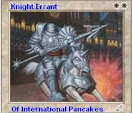Take the following diagram
 |
| Black to move. |
5k2/8/7K/2rn4/1p5p/1R6/2p3PP/2R5 b - - 1 1
[solution]
If you look at the move 1. ... Nf4, you see that this move accomplishes three logical tasks
- covering h5, which is a point of pressure
- covering g6, which is a wall of the box
- clearing the 4th rank for the black rook, which forms a part of the wall.
Can you see how these logical considerations of system 2 might inspire system 1 to work its miracles?

An interesting problem...in my case, I saw the mate possibility almost immediately, although the first ( instant) move that arrived was Nf6, which fails. That provoked a think ( ie "system 2") and Nf4 was the correct solution. I suspect my process was triggered by the mate practice that I do , based on your "frequency of mates" post and suggestions. Technically, this isn't 'edge mate' (your #1 most frequent mate ), as it's an Arabian mate, but I have previously spent much time practising Arabian mates and, added to the Edge mate practice I do now, it was straightforward to see.
ReplyDeleteThe last few months of your blog posts have been illuminating, as you identify and expand on the process of discovering and explaining the system 1 and 2, and some practical ways to use these. As mentioned, I am using the mate and theme frequency you suggested, and practising using Chess Tempo. I haven't yet expanded this to the depth you seem to use on each individual problem, although I do work through alternatives/options, especially if I fail or if there are alternatives that are not clear to me.
Looking forward to more discoveries, insights and suggestions !
Less is more. We are really addicted to big numbers. And to complexity. The logic of this problem seems to be very modest. And therefore it is easy to underestimate it.
DeleteWithout trying to classify this mate (Arabian mate), there are some interesting things about it. Please note: the sequential order described below is NOT how I saw the solution. Several of the “steps” occurred subconsciously.
ReplyDeleteThe Black King controls 2 squares (g7-g8) of a potential “wall” on the edge of the board (g5-g6-g7-g8). The Black Rook (“seeing” through the BNd5 “obstruction” to the edge of the board) potentially controls g5 and can reach h5 (a PoP or focal point). The only “escape hole” for the White King is thus g6.
The most pressing problem is how to cover that g6 escape hatch?
The Black Knight can accomplish several desirable things with one move [1...Nf4]:
(1) Add a second attacker to the focal point h5, thereby gaining control of it [1:2].
(2) Open the LoA of the Black Rook to the focal point h5.
VERY IMPORTANT!
(3) Control the escape hatch g6, preventing the White King escaping from the “box.”
(4) Block any possible checks by the White Rooks, which would force the Black King to move AND prevent the Black Knight from reaching f4.
Consideration: the Black Knight can only control BOTH the focal point h5 AND the escape square g6 from the f4 square.
How can White disrupt the threatened mate?
All Rook moves are a tempo behind. The only possibility is to attempt to regain control of the focal point with [2. g4]. Unfortunately (for White), that fails to [2...hxg e.p.], which has two purposes: (1) it removes that g4 Pawn’s control from h5 AND (2) it blocks any White Rook move to h3.
White will be mated by [3...Rh5#.
That is a post-facto rationalization that does not match what consciously happened in my mind. All I was aware of was “seeing” the possibility of getting the Rook to h5 and the need to close the “box” on g6. As soon as I “saw” that, the first move was obvious. Immediately after, the followup came to mind.
Nice to see your latest posts . Will comment in time.
ReplyDelete